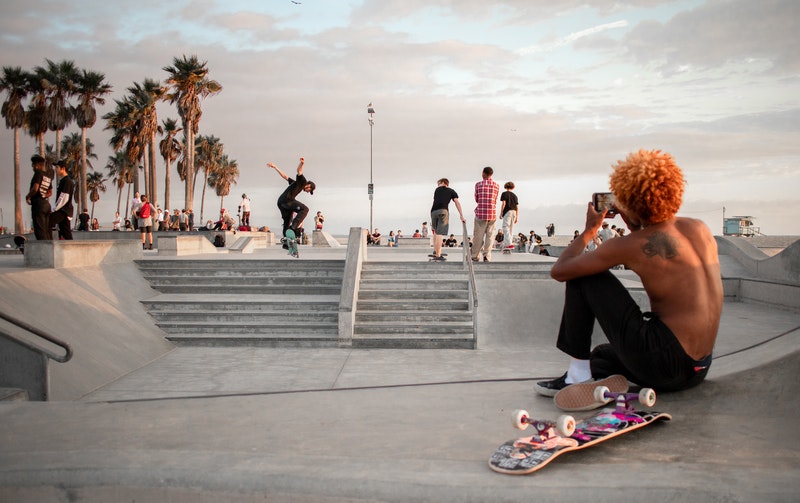Intro
You may wonder: “ Do I need a helmet for longboarding?” thousands of times when you have the first taste of longboarding.
No worries! In this article, you will find out the answer, understand essential knowledge about helmets, and learn how to choose them correctly.
[toc]
Do I Need A Hat For Longboarding?
The answer entirely depends on the rider. Wearing a helmet is not compulsory for free players yet a prerequisite in professional boarding events.
If you are new to longboarding, a helmet is absolutely necessary. However, as you become more experienced, you may not need to wear it when cruising or doing simple flips and tricks.
Nevertheless, wearing a helmet is not superfluous. It saves your life from unexpected accidents. Even if you are an expert, you can not predict when you will get hit by a car or trip over an obstacle. Therefore, protective gear is the first thing you need after your skateboard.
Arguments About Wearing A Hat
There has been a heated debate between riders in the boarding community whether they should wear a helmet. Here are some arguments from both sides:
Opponents Of Wearing Helmet
- There is little chance of falling when going at low speed. Cruising at about 15 miles per hour is relatively like jogging. And nobody wears protective gear for jogging, don’t they?
- Such a nuisance when your helmet makes you sweat during the ride. This pet peeve can ruin the whole exciting riding experience.
- If you fall, you will instinctively land on your hands. Gloves or elbow pads are much needed than the product in this case.
- Skilled skateboarders know “how to fall” correctly. They will not let themselves fall backward, which is the easiest way to cause head damage.
Advocates Of Wearing A Hat
- However experienced the riders are, they all face the risk of getting seriously injured.
- Cruising in a relaxed gesture with no knee-bending can get you injured.
- No one knows when a car is dashing towards you. Better be safe than sorry!
- In several cities, you might receive a warning ticket for not wearing helmets while boarding. Do you want to pay a fine for such a silly reason?
- Being a skilled player, one also needs to be a role model for beginners.
See more: Negative Effects Of Skateboard
How Dangerous Is Longboarding?
Well, what a tough question. Whether longboarding is damage-threatening depends on various factors: riding style, skill, cautiousness, and even luck.
No matter how many years you have ridden longboarding, bruises and scratches are probably inevitable. Serious injuries usually result from doing tricks incorrectly, or worse, unwanted accidents.
For less skilled riders, such tricks as downhill riding or freestyle riding are one of the typical causes of severe injuries.
You may trip over a pebble or the uneven surface
The research named “Boarding Injuries: The Long and Short of it” has shown that longboarders are more prone to suffering from serious damages than skateboarders. Most injuries are related to upper body parts, including concussion, internal head bleeding, and skull breaks.
In 2019, a 21-year-old man named Ryan Torrey hit his head while skateboarding at a park in Amherst. His friends reported that he did not wear a helmet when skating. Ryan was then in a coma and died a few days later.
It was a tragic accident. Just a minor mistake can lead to a huge regret.
You have your choice of either wearing or not. However, looking at the above reasons and examples, which one do you choose? A safe life or a cool guy?
Voila, the answer is clear now. Safety first, coolness later.
When To Wear?
Again, this issue completely relies on you. If you want, just do it.
Cruising or commuting on an even surface in a short distance does not require a hat. But if you are about to perform some skillful tricks you have learned, then a helmet is a must-have item. Such tricks are:
- Freeriding and downhill
- Dancing or freestyling
Apart from helmets, we highly recommend wearing full pads (knees, elbows), gloves, and crash pants.
Without safety gear, you are both skating and gambling your life. So remember, safety is the top priority.
How To Choose A Good Product?
The criteria for a good helmet are various due to personal interests. However, there are two main structures of helmets that you can easily find in the market or online stores: Full Face and Half Shell.
Here is handy general information about these types. Read it carefully because it will help you to choose the best helmet.
Half Shell Helmet
A half shell (also known as a “bucket”) is a standard helmet. This type of helmet is ubiquitous, with the classic bucket shape covering the rider’s head and a string crossing his chin.
Half-shell
Hard-shell vs Soft-shell
A basic half shell has a thick layer protecting your head. This padding is called “hard-shell”. The outer layer is made from ABS plastic, and the inner one uses EPS plastic to reduce the impact. EPS foam is best known for its lightweights.
Meanwhile, a “soft-shell” shares the same amount of layers, yet it has a softer foam liner. A softer layer means that the level of protection is not as high-quality as that of hard-shell.
You know what to avoid and what to buy now. A hard shell for the utmost protection.
Soft-shell cover (left) vs Hard-shell cover (right)
Hard-shell Construction
Hard-shell is now your option, but there’s more about it.
There are two popular types of construction: hard-shell and in-mold.
In the in-mold structure, the EPS layer is glued completely into the outer shell. This construction creates a strong bond between the constituents.
Meanwhile, the inner EPS in a hard shell is attached to the outer at several points. In the long run, you will see the two parts gradually separated.
Hard-shell construction (left) vs In-mold construction (right)
Which Is Half-shell Best For?
Half shell is best for commuting, simple longboarding tricks like dancing or slalom. However, when it comes to more complex performances, a half shell is not the most favorable choice since its design is not able to protect other facial parts like eyes, jaws, and ears.
Full Face Helmet
Compared to Half-shell, Full Face offers 360-degree protection since they cover all your head.
Full Face Hat Design
Most Full Face helmets are designed with a removable visor, which prevents dust and flying insects. The visor also helps you avoid the radiant sunlight while skating.
Full-face
They share the same manufacturing way with Half-shell: a hard ABS outer shell, an inner EPS foam layer, and an additional foam for better fitness.
Which is Full Face best for?
This type of helmet is totally ideal for riding downhill or complicated skateboarding. In fact, riders must wear Full-face helmets in professional longboarding or skateboarding contests.
Indeed, A full-face helmet is undeniably the safest helmet.
Helmet Certification
Finally, you have a helmet. Let’s start longboarding!
Wait, is your hat validated? Do you want to risk your head with low-quality protection?
When buying a product, you should not overlook helmet certification. It shows whether your hat is properly tested and manufactured. Also, certification guarantees safety standards in sports.
If your helmet has one of the following marks, then it is definitely a great choice.
ASTM – American Society for Testing and Materials (USA)
ASTM is an international standards organization that establishes consensus technical standards for a wide range of materials, products, systems, and services.
Your hat should contain one of these stamps:
- ASTM: F1492, F1447, F1492, F1952
CSPS U.S. Consumer Product Safety Commission (USA)
A CSPS mark ensures that the helmet is safe for cycling. Sign CPSC 1203 indicates your hat is tested and suitable for cyclers. Unfortunately, CSPS has not released a mark for skateboarding.
CE certification mark (EU)
When you buy a helmet in European countries, a CE certification is a validation proving that your hat satisfies the requirements about health, environment, and safety of the European Economic Area.
The most common mark is CE EN 1078.
Let’s wrap up
In conclusion, helmets play an important role in protecting riders from serious injuries, especially brain damage. Under no circumstances should you risk your life by not wearing safety gear.
Choosing the most suitable and high-quality helmet is also as essential as wearing it. There are a wide array of helmets with eye-catching designs that you can pick up. But remember that the quality must be prioritized first and other factors later.
Hope that this article has given you a satisfying answer about “Do I need a helmet for longboarding?” and useful pieces of advice. What kind of helmets are you using? Share with us your experience.
Related posts: Is It Illegal To Ride A Skateboard Without A Helmet
Reference: Do I Need a Helmet for Longboarding



